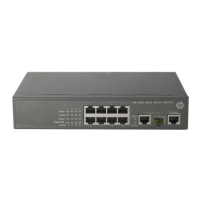To do... Use the command... Remarks
Associate the class with the
behavior to map the SVLAN to the
CVLAN
classifier tcl-name behavior behavior-name Required
Configuring the customer-side port
Follow these steps to configure the customer-side port:
To do... Use the command... Remarks
Enter system view system-view —
Enter Layer 2 Ethernet interface
view
interface interface-type
interface-number
—
Configure the port as a trunk port
port link-type trunk
Required
The default link type of an Ethernet
port is access.
Assign the port to CVLANs and
SVLANs
port trunk permit vlan { vlan-id-list
| all }
Required
By default, a trunk port belongs to
VLAN 1 only.
Apply the uplink policy to the
incoming traffic
qos apply policy policy-name
inbound
Required
Apply the downlink policy to the
outgoing traffic
qos apply policy policy-name
outbound
Required
Configuring the network-side port
Follow these steps to configure the network-side port:
To do... Use the command... Remarks
Enter system view system-view —
Enter Layer 2 Ethernet interface
view
interface interface-type
interface-number
—
Configure the port as a trunk port
port link-type trunk
Required
The default link type of ports is
access.
Assign the port to SVLANs
port trunk permit vlan { vlan-id-list
| all }
Required
By default, a trunk port belongs to
VLAN 1 only.
Configuring many-to-one VLAN mapping
Perform many-to-one VLAN mapping on the wire-closet switch (see Figure 49) to transmit all types of
traffic from the same customer in one VLAN.
Perform these tasks to configure many-to-one VLAN mapping:
158

